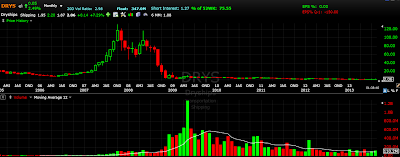On any given day there are only 5 pieces of information given by stocks, the open, the high, the low, the close, and volume. This is the skeletal structure of the market from which numerous calculations and abstractions have been fleshed out as a means of giving traders a clearer view and understanding of the underlying structure and essence. It’s almost as if there is a constant pursuit to get further and further away from price and volume, but the farther one travels away, the smaller the observed object becomes until eventually it disappears from sight altogether.
For the past year I’ve been increasingly focused on price/volume relationships and what I’ve found bemusing is the often times polarizing debate around the significance of the only two pieces of information the market gives. There’s an argument that only price matters since only price pays and on the flip side there are arguments along the lines of price without volume is suspect. There’s a number of variations on this theme, but the resoluteness with which each side speaks comes across as if the chicken or the egg has been solved.
So, which is it? One of the few structural edges in the market is momentum. It has been shown that by calculating a price rate of change over 3, 6, and/or 12 month periods and ranking these by baskets, that the top 10% will outperform the next 10% which outperform the following 10% etc... From this we can state that in order to have an enduring edge in the market all one needs to trade is price.
However, the old adage that price follows volume can also hold true as well, but from my perspective in order for this to be more effective price must be lacking momentum in the first place. This makes sense empirically for if price is already rising and the momentum effect has already kicked in, then this in and of itself is sufficient for expectation of higher prices in the near future, whereas if price is in neglect and volume historically anemic, then a spike in volume can put one on alert that there is a potential supply/demand of the underlying stock occurring as stronger hands begin their accumulation period.
Two recent examples I’ve noted have been WLT and FB. Walter Energy has clearly been in a downtrend for the past three years and is in the range of historical lows which is an indication of neglect. Currently price is showing no signs of a momentum shift, but it may be showing signs of a supply/demand imbalance. A glance at the weekly with attention on volume suggest this.
 |
| WLT |
Facebook has been a pariah since its IPO, but any left over disdain for this stock should be thrown out with the bathwater. Since its debut, price continued a descent which erased nearly 60% of the value over the next 4 months. There were some indications that a bottom may have been in place around the $18 range, but the November 2012 momentum phase stalled and the action since has been mostly range bound. On July 25, an earnings catalyst propelled price 30% on volume that was about 20% of the float. In conjunction, momentum on a 3 and 6 month period kicked in as well.
 |
| FB |
There’s a concept called float turnover ratio analysis which is the study of volume relationship to a stock’s float and the amount of turnover in a given period. One of the inherent problems with this is that it can’t be easily replicated. I’ve found no public source of information and my scanning programs do not allow for a stock’s float to be used in calculations. Seems to me the only option is building and maintaining a database, but the time consumption of daily maintenance and upkeep as well as accuracy of source has been a hindrance, so I’ve opted to make due with what I have.
At the end of each month I run a scan that looks for the highest volume over a 12 month period, and at the end of each week I run a scan that looks for the highest weekly volume over a 2 year period. One of the things I’m looking for are the outliers that stick out like sore thumbs and come close to or eclipse the stocks float, especially when followed shortly thereafter by momentum.




















